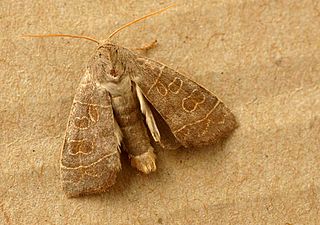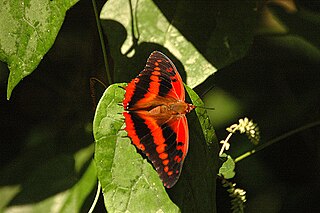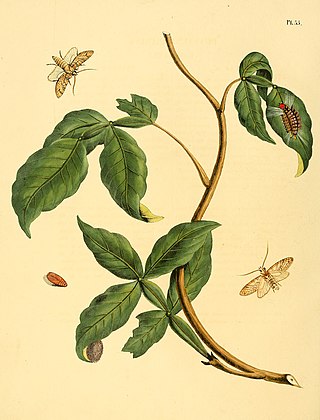
Atrophaneura schadenbergi is a species of butterfly in the family Papilionidae. It is endemic to the Philippines.

Ipimorpha subtusa, the olive, is a moth of the family Noctuidae. It is found in the Palearctic realm.

Hydraecia micacea, the rosy rustic, is a moth of the family Noctuoidea. It is found across the Palearctic realm from Ireland to Siberia. It reaches Japan and is introduced to eastern USA, Quebec and Ottawa.

Lacanobia contigua, the beautiful brocade, is a moth of the family Noctuidae. The species was first described by Michael Denis and Ignaz Schiffermüller in 1775. It is found throughout temperate regions of the Palearctic realm, from Ireland east to Siberia and Japan.

Agrotis ripae, the sand dart, is a moth of the family Noctuidae. The species was first described by Jacob Hübner in 1823. It is found in western Europe and North Africa and extends east across the Palearctic to steppe areas in Russia, Mongolia and Siberia.

Grammodes stolida, the geometrician, is a moth of the family Erebidae. The species was first described by Johan Christian Fabricius in 1775. It is found in Africa, southern Europe, most of Asia and Australia. It migrates to central and northern Europe as far north as England, Denmark and Finland.

Parasa lepida, the nettle caterpillar or blue-striped nettle grub, is a moth of the family Limacodidae that was described by Pieter Cramer in 1799. It is a native minor pest found in the Indo-Malayan region, including India, Sri Lanka, Vietnam, Malaysia and Indonesia. It is an introduced pest to urban trees in western Japan.

Corybantes mathani is a moth in the Castniidae family. It is found in South America, including Venezuela, Guyana and Peru.

Charaxes cynthia, the western red charaxes, is a butterfly in the family Nymphalidae. It is found in Senegal, Guinea, Sierra Leone, Liberia, Ivory Coast, Ghana, Nigeria, Cameroon, Gabon, the Republic of the Congo, the Central African Republic, the Democratic Republic of the Congo, Uganda, Angola, Sudan, Uganda, Kenya, Tanzania and Zambia.

Aporophyla australis, the feathered brindle, is a moth in the family Noctuidae. The species was first described by Jean Baptiste Boisduval in 1829. It is found in western and southern Europe, North Africa and the Middle East.

Colias hyperborea is a butterfly in the family Pieridae. It is found in the East Palearctic.

Colias lesbia is a species of butterfly in the family Pieridae. It is found in the Neotropical realm.

Lophocampa citrina is a moth of the family Erebidae. It was described by Jan Sepp in 1843 as Phalaena citrina. It is found in Mexico, Honduras, Panama, French Guiana, Brazil, Venezuela and the Amazon region.
Lophocampa indistincta is a moth of the family Erebidae. It was described by William Barnes and James Halliday McDunnough in 1910. It is found in California, where it is only found on the Channel Islands.
Alatuncusia gilvicostalis is a moth in the family Crambidae. It was described by George Hampson in 1918. It is found in Peru.
Astatochroa sulphurata is a moth in the family Drepanidae. It was described by William Warren in 1907. It is found in Papua New Guinea.

Teliphasa erythrina is a species of moth of the family Pyralidae. It is found in China (Yunnan).
Uzucha humeralis is a moth in the family Xyloryctidae. It was described by Francis Walker in 1864. It is found in Australia, where it has been recorded from New South Wales and Queensland.
Megalopyge salebrosa is a moth of the Megalopygidae family. It was described by James Brackenridge Clemens in 1860. It is found in Mexico and Guatemala.
Mesoscia dyari is a moth of the Megalopygidae family. It was described by Schaus in 1912. It is found in Costa Rica.













